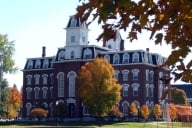You have /5 articles left.
Sign up for a free account or log in.
BALTIMORE – By opening on-campus preventative care centers that both serve the uninsured and provide allied health students with real-world clinical experience, one community college is trying to remedy the health care crisis in its own backyard.
Officials from Cuyahoga Community College, in Cleveland, detailed the ups and downs of the college’s two new Community Health, Wellness and Preventative Care Centers to interested colleagues here at this week’s meeting of the League for Innovation in the Community College. Opened in August, the centers are the result of nearly $3 million from a Department of Labor Community Based Job Training Grant. College officials said they believe the centers to be the only community college facilities of their kind in the country.
Cuyahoga awards the 10th largest number of health professions and related science associate degrees in the nation, and more than 6,000 students enroll in its nursing and health careers programs each year. Given this, the college had a serious need for more laboratory space and clinical sites for student experience prior to the opening of the new centers.
Patricia M. Gray, vice president of health care education initiatives, also noted that the recession has had a “devastating impact on the city of Cleveland and its workforce.” Almost 30 percent of the city’s residents live below the poverty level, and 9.4 percent are unemployed; 17.6 percent of adults ages 18 to 64 lacked health insurance last year. Gray described the college’s centers, located on a downtown Cleveland campus and a suburban branch campus, as a way to help these needy residents while also training more health professionals.
The centers train, and provide the services of, health information technicians, physician assistants, medical assistants, occupational therapy assistants and physical therapist assistants. Licensed professionals in each of these fields, who typically hail from nearby hospitals and doctors' offices and are paid hourly wages by the college, supervise all of the student work. Still, given the nature of these fields, there are a number of services that the center cannot provide.
“We didn’t want to call it a clinic [because] we were concerned people would see us as another urgent care [facility] and that they would be coming in needing aspirin, Band-Aids and having sore throats,” said Barbara Mikuszewski, associate dean of health careers and natural science. “Those are prescriptive kinds of things, and that’s not what we’re designed to do, so we were very careful how we named the facility.”
Instead, the centers provide some of the following types of services free of charge: blood pressure, glucose and cholesterol screenings; "strengthening, stretching, endurance programs and postural training to prevent and manage back and neck pain"; and “exercise and education programs to promote wellness, manage life-long conditions and prevent injuries.”
Despite the college’s promotion of these facilities, the patients did not come immediately.
“We opened the doors, and we had no clients,” Mikuszewski said of their opening. “We really didn’t. We’d done a lot of marketing and branding, and that continues to be a challenge. It’s not as bad as it was. So what do you think was the biggest challenge? It wasn’t just that we didn’t have clients, but this was supposed to serve as a learning experience for students, so we had a compound problem here.”
Mikuszewski anticipates the centers can serve about 250 patients each semester, and said that their usage will increase as neighborhood residents spread the word about its free services. So far, she said, those who have used the centers have praised the students' work.
“Patient feedback has been outstanding,” Mikuszewski said. “The people just love it. They really do because our students are kind of nervous but they give them individualized attention. They know the patient’s name. They’re very careful about talking to them, giving them information and asking them questions because they, the students, are also being evaluated at the same time.”
Despite these early rave reviews, the centers face serious ongoing challenges. Foremost among them is that the college has yet to find a physician to supervise the center. This is a hassle, Gray said, because the college needs to find one who already has liability insurance personally or through his or her hospital, given its high cost. She added, however, that it is in talks with a number of doctors who may donate their time to the centers in the near future.
Further, Mikuszewski said, the college does not know how it will fund the centers once the Department of Labor grant runs out next year. The excitement of the centers’ students, she said, almost ensures that the college will find a way to make it work.
“One thing that helps students is the confidence,” Mikuszewski said. “They’re able to test what they’re learning in class with real patients. It’s not a lab. They’re real patients. They feel so much better about themselves when they go out and do additional clinicals.”







